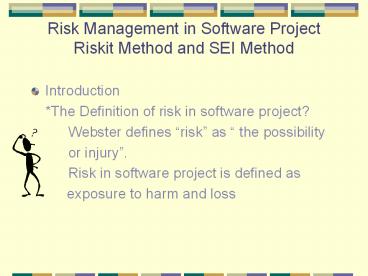Risk Management in Software Project Riskit Method and SEI Method - PowerPoint PPT Presentation
1 / 20
Title:
Risk Management in Software Project Riskit Method and SEI Method
Description:
Risk Management in Software Project Riskit Method and SEI Method Introduction *The Definition of risk in software project? Webster defines risk as the ... – PowerPoint PPT presentation
Number of Views:285
Avg rating:3.0/5.0
Title: Risk Management in Software Project Riskit Method and SEI Method
1
Risk Management in Software ProjectRiskit Method
and SEI Method
- Introduction
- The Definition of risk in software project?
- Webster defines risk as the possibility
- or injury.
- Risk in software project is defined as
- exposure to harm and loss
2
- Why do we need risk management?
- Risk management can help us to avoid
- software disaster, rework and overkill.
- Why do we need a formally risk management?
- Risks in different projects are individual
- differences.
- Rely on project managers intuition and luck
- are a poor substitute and consistent
approach. - Provides a number of benefits to the project
- team.
3
- When does the risk management apply?
- Start the risk management as soon as the
- project starts.
- What are features of risk management?
- Risk is uncertain
- Risks in project can never be removed
- Risks can be control and reduced
4
Riskit Method
- Definition
- Riskit method is a comprehensive risk management
method. - Goal
- Riskit method focuses on stakeholder goals by
maintaining links between risks and stakeholders
explicitly.
5
Riskit Method
- Definition of Risk
Risk
is characterized by
Is characterized by
Probability
Loss
is defined by
Expectations
is valued by
Stakeholder
6
Riskit Method Processes
- Risk Management Mandate
- Output -gt why, what, when and whom
- Goal Review
- Output -gt explicit goal definitions
- Risk Identification
- Output -gtA list of raw risks
- Risk Analysis
- Output -gtCompleted Riskit analysis graphs
- and ranked risk scenarios
7
Riskit Method Processes
- Risk Control Planning
- Output-gtSelected risk controlling
actions - Risk Control
- Output -gtReduced risks
- Risk Monitoring
- Output-gtRisk status information
8
Riskit Risk Management Cycle
mandate
Risk Mag Mandate
Goal review
changes
goal
changes
Monitoring
changes
revisions to goals
Identification
results
list of risks
Risk Control
risk monitor matrices
Analysis
selected action
Control planning
prioritized risk
9
SEI Risk Management Method
- Definition
- Software risk management address the entire lift
cycle of software acquisition, development, and
maintenance. - Goal
- To enable engineers, managers, and other
decision makers to identify risks and to manage
them on a time basis.
10
SEI Risk Management Paradigm
- Identify
- The taxonomy method consists taxonomy-base
questionnaire and a process for its application. - Analyze
- Analysis is the conversion of risk data into
risk decision-making information.
11
- Plan
- Turns risk information into decisions and
actions. - Track
- Monitor the status if risks and the actions
taken. - Control
- Corrects deviations from planned risk actions.
- Communicate
- Communication lies at the center of paradigm.
12
SEI RISK PARADIGM
13
SEI RISK MANAGEMENT PRINCIPLES
- Global Perspective
- Forward-looking View
- Open Communication
- Integrated Management
- Continuous Process
- Share Product Vision
- Team Work
14
Differences of Two Methods
- Riskit Method define a specific step risk
management mandate. - Riskit Method define goals and stakeholders for
project. - Riskit method uses brainstorming, checklist or
benchmarking to identify risks. SEI uses taxonomy
questionnaire method.
15
- Riskit Method provides more graphical analysis,
SEI provide textual analysis is based on taxonomy
method
Risk factor
Risk event
Risk Outcome
Reaction
Risk Effect set
Utility loss
16
Differences of Two Methods
- SEI focus on team members participation
- SEI focus on the participation of suppliers and
customers - SEI method shares product vision
- SEI method has open communication
- SEI provides a continues risk management
17
Simulations
- Both of them provide precise definition of risks.
- The basic concepts for risk management are the
same - Both of them suggest a common risk management
framework - Both of them are systematical processes
- Documentations are required
18
Simulation
- They all address project manager is not the only
person to participate risk management.
19
Conclusion
- Risk management framework is necessary.
- Some basic steps are necessaryidentification,
analysis, prioritization, planning, control and
monitoring. - Everybody who is related to this project need to
involve in risk management.
20
Conclusion
- Establish open communication for employees to
discuss risks. - Risk management should start before the project
starts.































